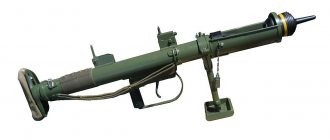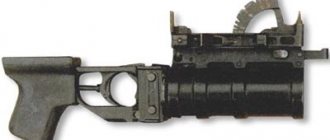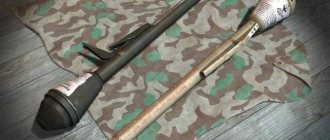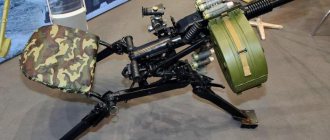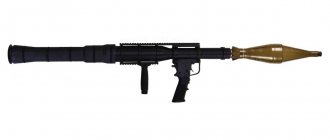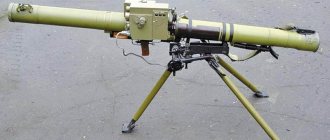Template:values
| Template:card/title | |
| Template:wikidata | |
| Weight and dimensions characteristics | |
| Caliber, | 88 mm |
| Weight, | 9.5 kg, with shield – 11.25 kg |
| Length, mm | 1640 mm |
| Combat characteristics | |
| Direct shot range, | 100—200 m |
| Sighting range, m | 150 m |
| Armor penetration, mm | 210 mm |
| Grenade weight, kg | 3.3 kg |
| Initial speed of the grenade, m/s | 105 m/s |
| Grenade head caliber, mm | — |
Panzerschreck
(Template:lang-de - “terror of tanks”; officially Template:lang-de2, from Template:lang-de2 - “anti-tank rocket gun”) - German hand-held anti-tank grenade launcher.
It was equipped with a shield, unlike the basic version of “ Ofenror
” (Template: lang-de2 - “stove pipe”; officially Template: lang-de2).
"Ofenror" and "Panzerschrek" were quite powerful weapons, but rather bulky to carry and difficult to manufacture.
Story
Development
In 1943, an attempt was made in Nazi Germany to solve the problem of anti-tank defense with the help of the Ofenror rocket-propelled hand-held anti-tank grenade launcher (RPG) .
"(German Ofenrohr - “stove pipe”), officially called RPzB. 43. It fired cumulative-action rocket-propelled grenades of 88 mm caliber at a range of up to 150 m, with an armor-piercing power of 150-220 mm.
The grenade launcher was based on the design of a captured American Bazooka anti-tank grenade launcher and consisted of a smooth-walled tube open at both ends with three guides, a pulse generator with electrical wiring and a plug box, a trigger mechanism and a sight. On the battlefield, the grenade launcher was serviced by a crew of two people: a gunner and a loader.
The pipe at the rear end had a ring that protected the channel from contamination and damage, and also made it easier to insert a grenade into the pipe channel. The tube also had a shoulder rest with a shoulder pad, two handles for holding the gun when aiming, two swivels with a belt for carrying a grenade launcher, and a spring latch for holding the mine in a loaded grenade launcher. Ignition of the mine's reactive charge at the moment of firing was ensured by a pulse generator and a firing mechanism.
A soldier with Ofenror wearing a gas mask that protects against powder gases.
The grenade launcher was fired using a sight consisting of front and rear sights. To protect against the hot powder gases generated during a shot, the gunner had to put on a gas mask (without a filter) and gloves before firing from the Ofenror gun. This circumstance significantly complicated the use of the weapon, so in 1944 a modification appeared, equipped with a protective shield. It is known as Panzerschreck
"(German Panzerschreck - "thunderstorm of tanks"), official designation RPzB. 54.
It is characteristic that “arctic” - for the northern sectors of the Eastern Front and “tropical” - for North Africa - modifications of the grenade were created. [ source not specified 833 days
]
TTX
| Option | Weapon weight, kg | Length | Caliber | Initial speed of the grenade, m/s | Actual fire range | Price | Armor penetration, mm |
| Panzerschreck 54 | 9.5 kg, with shield 11.25 kg | 1640 mm | 88 mm | 105 m/s | 100—200 m | 70 Reichsmarks | 200 |
Production
Panzerfaust and Panzerschreck
| Year | Panzershrekov | Pomegranate |
| 1943 | 50 835 | 173 000 |
| 1944 | 238 316 | 1 805 400 |
| 1945 (January to March) | 25 744 | 240 000 |
| Total | 314 895 | 2 218 400 |
Interestingly, for the 314,895 grenade launchers produced, 2,218,400 rockets were fired, that is, only about 7 units per grenade launcher. [ source not specified 833 days
]
Application
Finnish soldiers with a German Panzerschreck
A Canadian sergeant demonstrates a Panzerschreck, 1944.
Ofenror and Panzerschreck grenade launchers were primarily armed with anti-tank companies of motorized rifle regiments of tank divisions at a rate of 36 guns per company. At the end of 1944, each Wehrmacht infantry division had 130 Panzerschreck grenade launchers in active use and 22 spare ones. [ source not specified 833 days
] These grenade launchers also entered service with some Volkssturm battalions.
Rocket-propelled grenade launchers were an exceptionally powerful anti-tank weapon. But, as Eick Middeldorf, an officer of the German General Staff on the Eastern Front, noted, the results of the fight against tanks declined sharply from January 1945, when “the Russians began to use a new method of defense against tank destroyers, which consisted of guarding their vehicles during the battle with separate riflemen located at a distance of 100-200 m from the tank. If, due to the nature of the terrain, the tank destroyer did not have conditions for cover, close combat with tanks became impossible.” [ source not specified 833 days
] And also wrote: “anti-tank defense is, without a doubt, the saddest chapter in the history of the German infantry... Apparently, it will remain completely unknown why, within two years from the appearance of the T-34 tank in June 1941 until November 1943 no acceptable anti-tank infantry weapon was created.” [
source not specified 833 days
]
Luftfaust-B
Luftfaust-B with a removable “clip” of 9 shells
A German 9-barreled anti-aircraft grenade launcher, which was created to destroy low-flying air targets. Aircraft flying at low speed at an altitude of up to 200 meters could be successfully shot down with this grenade launcher.
In 1945, the German command placed an order for 10,000 Luftfaust-B anti-aircraft grenade launchers, but in reality up to 100 units were produced. They planned to produce powerful weapons using concentration camp prisoners.
German soldier with Luftfaust-B grenade launcher
The grenade launcher itself was a housing in which 9 smooth-bore pipes were connected. The shooting was carried out with a modified 20-mm incendiary fragmentation projectile. The grenade launcher was equipped with an electric fuse. After pressing the trigger, the electrical circuit was closed and the entire ammunition load was fired - 5 shells at the same time, and after another 100 milliseconds the remaining 4.
The Luftfaust-B grenade launcher could be quickly reloaded thanks to its nine-round clip. After the shot, the soldier could quickly insert the next set of 9 20-mm shells into the grenade launcher and open fire again.
Characteristics:
Appearances in computer games
- The Saboteur
- Medal of Honor (game, 1999)
- Medal of Honor: Allied Assault
- Medal of Honor: Frontline
- Medal of Honor: Airborne
- Call of Duty: United Offensive
- Call of Duty 2
- Call of Duty 3
- Call of Duty: World at War
- Call of Duty: Black Ops
- Call of Duty: Finest Hour
- Call of Duty 2: Big Red One
- Call of Duty: Roads to Victory
- Call of Duty: World at War Final Fronts
- Brothers in Arms: Hell's Highway
- Company of Heroes
- Company of Heroes 2
- BloodRayne
- Wolfenstein
- Battlefield 1942
- Behind Enemy Lines 2
- World War II (game)
- Blitzkrieg
- Blitzkrieg 2
- Heroes & Generals
- Hidden & Dangerous 2
- Iron Front: Liberation 1944
- Operation Silent Storm
- Hour of Victory
- Day of Defeat
- Heroes and Generals
- Sniper Elite 3
- Indiana Jones and the Emperor's Tomb
Panzerschreck
German anti-tank crew with a Panzerschreck grenade launcher
The anti-tank rocket launcher was equipped with an 88-mm rocket-propelled grenade. The weapon turned out to be powerful, but bulky and inconvenient to use. From a range of 150 meters it was possible to penetrate tank armor up to 200 mm.
The first version of the grenade launcher, which was called “Ofenror,” did not have a protective shield. Before shooting, the soldier had to wear a gas mask and gloves to protect himself from powder gases. This point greatly complicated the use of the grenade launcher in combat conditions.
Grenade launcher Ofenror
Later, versions with a protective shield appeared, and the gas mask was no longer needed. The Wehrmacht anti-tank units were armed with the Panzerschreck grenade launcher. By 1944, each German division had 130 anti-tank grenade launchers.
German soldier preparing to shoot
Despite its enormous power, the Panzerschreck grenade launcher did not cause significant losses to Soviet tank units. After the appearance of grenade launchers in German arsenal, Soviet troops changed the tactics of using tanks. Now each tank was guarded by separate riflemen, who walked at a distance of 150-200 meters from the vehicle and suppressed the fire of German anti-tank crews.
German soldiers with a Panzerschreck grenade launcher in position
Characteristics:
These hand grenade launchers were used by German soldiers during the Great Patriotic War. Despite the presence of this type of weapon in German combat units, it was not possible to break the offensive of Soviet tank units. Our tanks took part in all major operations and losses from grenade launchers were insignificant.
Soviet troops used a proven weapon to fight German tanks - an anti-tank rifle. In skillful hands, such a gun turned into a real tank destroyer.
Description of design
The Panzerschreck grenade launcher consisted of a smooth-bore metal pipe of 88 mm caliber with three guides. On it were:
- induction generator;
- sighting devices;
- trigger mechanism;
- shoulder rest with shoulder pad;
- handles for holding weapons;
- a latch that holds the grenade in the loaded position.
A wire ring was placed on the breech end of the barrel, which protected it from contamination and facilitated loading. The trigger included a spring-loaded trigger lever, an impact rod, a mainspring and a handle for cocking the rod with a safety lock. The sighting devices of the grenade launcher consisted of two sights. There was also a metal shield on the pipe that protected the grenade launcher from the rocket exhaust gases.
RPzB.GR.4322 caliber cumulative missiles were used to fire the Panzerschreck and Ofenror. This ammunition had a mass of 2.4 kg and an initial speed of 115 m/sec. The propellant charge was located in the grenade itself, and its ignition was carried out by an electric fuse (like a Bazooka). The grenade was equipped with an impact fuse; it was cocked at a distance of approximately three meters from the muzzle of the weapon.
When shooting at a distance of 75 meters, the fighter was instructed to choose an aiming point below the tank’s hull. At a range of 75 to 120 meters it was located between the turret and the control compartment, and at distances from 120 meters it was necessary to aim at the turret. When firing during a flanking movement, the fighter had to aim his weapon at the front of the tank corps.
The gunner had to carefully ensure that there were no people, ammunition or flammable materials in the affected area behind the grenade launcher
The instructions paid special attention to this issue.
The RPzB 54 anti-tank rocket launcher is an improved version of the RPzB 43 model, which in turn was developed on the basis of the American Bazooka. The main difference is the increased caliber and, accordingly, a more powerful warhead charge.
In the first months of 1943, German troops, trying to hold back the advance of the Allied forces in Tunisia, used captured American 60-mm Bazooka M1 anti-tank rocket launchers. They were soon sent to Germany for study and testing by German engineers, who highly appreciated the combat capabilities of this weapon, which was distinguished by its simple and therefore cheap to manufacture design.
A short time later, a German version of the Bazooka appeared. The German grenade launcher fired grenades similar to those used in the Püppchen system, but converted to an electric trigger. The first German grenade launcher was named 8.8-cm “Raketenpanzer-buechse” 43 (8.8-cm RPzB 43). It was a trunk open on both sides, that is, a simple pipe. The grenade was loaded from the rear, after which the shooter placed the barrel on his shoulder and charged a small electric generator using a lever before releasing it. The current obtained in this way was transmitted through wires to the grenade engine for firing. The weapon was equipped with a simple aiming system.
The RPzB 43 grenade launcher turned out to be successful. Larger than in the Bazooka, the grenade had better armor penetration, since the ability of a cumulative warhead, when detonated, to form a directed stream of hot gases to burn through the armor, directly depends on the size of the warhead. However, it was not without its drawbacks. In addition to the short firing range (only 150 m), another serious problem was identified: when leaving the barrel, the grenade engine continued to work, this meant that the strap had to be dressed in protective clothing and a gas mask to avoid burns. When fired, the jet stream escaped from the barrel back several meters, producing a cloud of dust and smoke that immediately gave away the position of the grenade launcher. As a result, the RPzB 43 did not gain much popularity among the troops.
Chronology
| № | date | Place | Participants | Countries | Motto |
| July 25 – August 16, 1947 | 17 000 | 71 | “Youth, unite, forward to the future world!” | ||
| August 14-28, 1949 | 20 000 | 82 | “Youth, unite, forward to future peace, democracy, national independence and a better future for the people” | ||
| III | August 5-19, 1951 | 26 000 | 104 | “For peace and friendship - against nuclear weapons” | |
| August 2-16, 1953 | 30 000 | 111 | "For peace and friendship" | ||
| July 31 – August 14, 1955 | 30 000 | 114 | “For peace and friendship - against aggressive imperialist alliances” | ||
| July 28 – August 11, 1957 | 34 000 | 131 | "For peace and friendship" | ||
| VII | July 26 – August 4, 1959 | 18 000 | 112 | "For peace and friendship and peaceful coexistence" | |
| VIII | July 27 – August 5, 1962 | 18 000 | 137 | "For peace and friendship" | |
| July 28 – August 6, 1968 | 20 000 | 138 | "For solidarity, peace and friendship" | ||
| X | July 28 – August 5, 1973 | 25 600 | 140 | ||
| XI | July 29 – August 7, 1978 | 18 500 | 145 | "For anti-imperialist solidarity, peace and friendship" | |
| XII | July 27 – August 3, 1985 | 26 000 | 157 | "For anti-imperialist solidarity, peace and friendship" | |
| XIII | July 1-8, 1989 | 22 000 | 177 | "For anti-imperialist solidarity, peace and friendship" | |
| XIV | July 29 – August 5, 1997 | 12 325 | 136 | "For anti-imperialist solidarity, peace and friendship" | |
| XV | August 8-16, 2001 | 6 500 | 110 | “We globalize the struggle for peace, solidarity, development, against imperialism” | |
| XVI | August 4-19, 2005 | 17 000 | 144 | “For peace and solidarity, we fight against imperialism and war” | |
| XVII | December 13-21, 2010 | 15 000 | 126 | "For victory over imperialism, for world peace, solidarity and social change" | |
| XVIII | December 7 – 13, 2013 | 8 000 | 88 | “Youth united against imperialism, for world peace, solidarity and social change” | |
| XIX | October 14 – 22, 2017 | ~20 000 | ~150 | “For peace, solidarity and social justice, we fight against imperialism – by respecting our past, we build our future!” |
58-mm anti-tank system M-1 "Bazooka"
In 1942, the 58-mm M-1 anti-tank system with a cumulative action grenade, called an anti-tank rifle (ATR), entered service with the American army. Bazooka is the name of a musical wind instrument. This name was apparently applied to the anti-tank rifle due to the combination of the unusual tone and loud sound of the shot and the design of the launcher in the form of a smoothbore pipe.
According to the design of the device, the “Bazooka” was a recoilless weapon from which a rocket-propelled anti-tank grenade was fired. Shot 2 for the Bazooka consisted of a cumulative caliber grenade with a jet powder engine and a stabilizer with rigid blades. The PTR was loaded from the breech of the barrel. To fire, the barrel was held on the shoulder. When the trigger was pressed, the electrical contacts closed. An electric current pulse (from two dry-charged batteries) was supplied through wires to the electric igniter of the grenade's jet engine. Under the influence of reactive force, the grenade began to move along the barrel and flew out of it at a speed of 90 m/s. Powder gases from a working jet engine flowed back, balancing the recoil. The operation of the jet engine ended by the time the grenade was launched. Aiming of the PTR was carried out using a sighting device with a slot and a vertical bar with four front sights located on the barrel (each front sight for a certain range of up to 200 m). The Bazooka anti-tank rifle laid the foundation for reusable hand-held anti-tank grenade launchers, which were later created in a number of countries around the world.
| MAIN PERFORMANCE CHARACTERISTICS OF AN ANTI-TANK RIFLE M-1 ≪BAZOOKA≫ REV. 1942 | |
| Ammunition used | Shot with a cumulative caliber grenade and a powder jet engine |
| Starting device | Recoilless, reusable |
| Barrel and grenade caliber, mm | 58 |
| Gun length, mm | 1380 |
| Combat rate of fire, rds/min. | up to 4 |
| Sighting range, m | 200 |
| Initial speed of the grenade, m/s | 90 |
| Armor penetration, mm | 90 |
Panzerfaust 60
Soldiers with Panzerfaust near a destroyed tank
Another disposable grenade launcher from Germany during the Great Patriotic War. The development of this weapon began in 1942. In essence, the Panzerfaust is an improved and modified version of the Faustpatron grenade launcher. As a result of improvements, German gunsmiths increased the diameter of the launch barrel to 50 mm, and the barrel length was 1 meter.
A special sight was installed on top. Throwing a grenade was carried out by detonating the powder propellant mixture. As a result of modifications, it was possible to increase the effective firing range to 60 meters.
The Germans are preparing to attack a tank
The grenade launcher fired a powerful anti-tank grenade of 149 mm caliber with an explosive mass of 800 grams. An alloy of hexogen powder in TNT was used as an explosive. The improved grenade made it possible to penetrate armor up to 200 mm.
Characteristics:
Characteristics of Panzerschreck
Below are the characteristics of the Panzerschrek RPzB 54 grenade launcher:
- length, mm: 1640;
- weight with shield, kg: 11.25;
- grenade weight, kg: 3.25;
- Max. firing range, m: 200;
- armor penetration, mm: 210.
German designers before and during World War II managed to create a whole range of new types of weapons, some of which, without exaggeration, can be called breakthrough. Cruise and ballistic missiles, cluster munitions, guided bombs, anti-aircraft missiles. This list can be continued. So the Internet meme about the “gloomy Teutonic genius” has very good grounds.
However, Germany achieved the most impressive results in the field of creating anti-tank weapons. Of course, the most famous of this group is “Faustpatron”, but it was not the only one. The German army was also armed with the Ofenror and Panzerschreck grenade launchers, and their design was much more advanced than the Faustpatron. Well, at the very end of the war, the Germans managed to create the first guided anti-tank missile, the Ruhrstahl X-7 (“Little Red Riding Hood”), but they didn’t have time to use it.
It’s curious, but all German grenade launchers from the Second World War are a clear example of technology theft. The model for them was the American Bazooka, which German troops first encountered in North Africa. True, we should give the Germans their due: they did not crudely copy someone else’s and introduced a lot of new things into the design of weapons.
Overall it was a good weapon, powerful and very effective. The main disadvantage of these German grenade launchers was their bulkiness. In addition, they were quite difficult to manufacture and expensive, which can be called a serious disadvantage for wartime weapons.
Serial production of the Panzerschreck began in 1943 and continued until the very end of the war. In total, German industry managed to produce 314 thousand grenade launchers and about 2.2 million ammunition for them. “Panzerschrek” (like “Ofenror”) were in service with Wehrmacht and SS units, and later began to enter the Volksturm. These weapons were used on all fronts of World War II.
Description of design
The Panzerschreck grenade launcher consisted of a smooth-bore metal pipe of 88 mm caliber with three guides. On it were:
- induction generator;
- sighting devices;
- trigger mechanism;
- shoulder rest with shoulder pad;
- handles for holding weapons;
- a latch that holds the grenade in the loaded position.
A wire ring was placed on the breech end of the barrel, which protected it from contamination and facilitated loading. The trigger included a spring-loaded trigger lever, an impact rod, a mainspring and a handle for cocking the rod with a safety lock. The sighting devices of the grenade launcher consisted of two sights. There was also a metal shield on the pipe that protected the grenade launcher from the rocket exhaust gases.
RPzB.GR.4322 caliber cumulative missiles were used to fire the Panzerschreck and Ofenror. This ammunition had a mass of 2.4 kg and an initial speed of 115 m/sec. The propellant charge was located in the grenade itself, and its ignition was carried out by an electric fuse (like a Bazooka). The grenade was equipped with an impact fuse; it was cocked at a distance of approximately three meters from the muzzle of the weapon.
When shooting at a distance of 75 meters, the fighter was instructed to choose an aiming point below the tank’s hull. At a range of 75 to 120 meters it was located between the turret and the control compartment, and at distances from 120 meters it was necessary to aim at the turret. When firing during a flanking movement, the fighter had to aim his weapon at the front of the tank corps.
The gunner had to carefully ensure that there were no people, ammunition or flammable materials in the affected area behind the grenade launcher
The instructions paid special attention to this issue.
